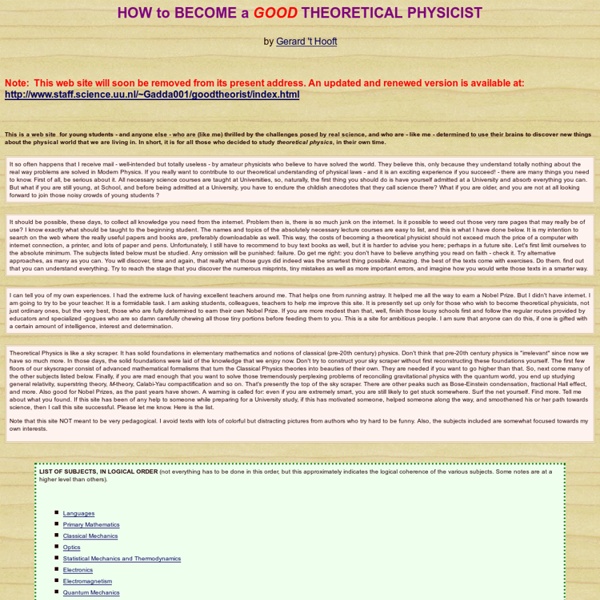Usenet Physics FAQ
Version Date: February 2018 This list of answers to frequently asked questions in physics was created by Scott Chase in 1992. Its purpose was to provide good answers to questions that had been discussed often in the sci.physics and related Internet news groups. Most of the entries that you'll find here were written in the days when the Internet was brand new. So because of their age, the FAQ entries that you'll find here have a great deal of academic credibility—but they are not always perfect and complete. This document is copyright. General Physics Particle and Nuclear Physics Quantum Physics Relativity and Cosmology Speed of Light Special Relativity General Relativity and Cosmology Black Holes Reference Topics There are many other places where you may find answers to your question. This FAQ is currently available from these web sites: Australia: England: Netherlands: Taiwan:
Stephen Hawking on time travel, M-theory, and extra terrestrial life
Stephen Hawking is near-universally recognized as a brilliant scientist, and one small facet of his complex genius is the rockstar ability to democratize scientific knowledge. It's becoming increasingly important as purveyors of pop culture continue to eschew acknowledgment and respect for the most basic scientific principles. Hollywood in particular has continued its marginalization of scientific knowledge with blatant disregard in recent films. But Hawking acts like a great counter force against anti-intellectual movements. So I (and everyone around me) felt a consummate air of curiosity in the Paramount Theater lobby on June 16, as Dr. The following are the press questions from Seattle-area colleagues that I read to Dr. What would it take to make time travel a reality, and how would that affect the present reality? We are all travelling forward in time anyway. How would you describe your quality of life?
Physics Simulations and Artwork
Here is a 3D view of a hydrogren atom in the 4f state. The left image was made in C++ using a technique described by Krzysztof Marczak to make it volumetric like a cloud of smoke. The right image was made in Mathematica by adding 2D cross-sectional layers. The animations were made in POV-Ray using DF3 density files. The right animation shows what a "12o" orbital might look like. POV-Ray has a built-in internal function for the 3d orbital: // runtime: 4 seconds camera{location 16*z look_at 0} #declare P=function{internal(53)}; #declare P0=P(0,3,0,0); box{-8,8 pigment{rgbt t} hollow interior{media{emission 0.5 density{function{(P(x,y,z,0)-1.2)/(P0-1.2)} color_map{[0 rgb 0][1 rgb 1]}}}}} Links Atomic Orbital - time-dependant hydrogen atom simulation, by ?
SUPERSTRINGS! M-Theory
M-theory is described at low energies by an effective theory called 11-dimensional supergravity. This theory has a membrane and 5-branes as solitons, but no strings. How can we get the strings that we've come to know and love from this theory? We can compactify the 11-dimensional M-theory on a small circle to get a 10-dimensional theory. How do we know that M-theory on a circle gives the IIA superstring, and not the IIB or Heterotic superstrings? The two that have been left out are the D6 and D8-branes. We can also get a consistent 10-dimensional theory if we compactify M-theory on a small line segment. So given this new phase 11-dimensional phase of string theory, and the various dualities between string theories, we're led to the very exciting prospect that there is only a single fundamental underlying theory -- M-theory. << Back | Home | Contents | Next >>
Mozilla Firefox (Build 20120905151427)
multiverse
A multiverse (or meta-universe) is the hypothetical set of multiple possible universes (including our universe) that together comprise all of physical reality. The different universes within a multiverse are called parallel universes. The structure of the multiverse, the nature of each universe within it and the relationship between the various constituent universes, depend on the specific multiverse hypothesis considered. Multiverses have been hypothesized in cosmology, physics, philosophy, theology, and fiction, particularly in science fiction and fantasy. The possibility of many universes raises various scientific, philosophical, and theological questions. Multiverse hypotheses in physics Classification According to Max Tegmark,1 the existence of other universes is a direct implication of cosmological observations. The levels according to Tegmark's classification and using Ellis, Koechner and Stoeger's terminology are briefly described below. Level I: (Open multiverse). Open multiverse
What is quantum superposition
Quantum matter can be difficult to study. While physicists have come a long way in the research of this microscopic science, some things are still a mystery because quantum matter can behave so erratically. Einstein's theory of relativity and various other laws of physics tend to fall apart at the subatomic level of quantum physics, because photons -- or tiny particles of light -- seem to change form randomly, and possibly change simply in observation. Quantum superposition is the term physicists use to describe the manner in which quantum particles appear to exist in all states simultaneously. Recently, scientists at the University of California, Santa Barbara, produced the first experiment in which quantum superposition in a visible object was observed.
multiverse
Multiverse Theory "This new concept is, potentially, as drastic an enlargement of our cosmic perspective as the shift from pre-Copernican ideas to the realization that the Earth is orbiting a typical star on the edge of the Milky Way." Sir Martin Rees, 1998, current Astronomer Royal of Britain There are stars with enough mass to collapse on themselves, forming what have been theorized as black holes. At the point of singularity it is agreed that it is impossible to predict physical behavior. The Multiverse theory for the universe has been a recently accepted theory that describes the continuous formation of universes through the collapse of giant stars and the formation of black holes. While the idea of a parallel universe may sound farfetched, a recent book from an Oxford physicist named David Deutsch entitled, "The Fabric of Reality: The Science of Parallel Universes - And Its Implications" describes the possibilities of tapping in on parallel universes. Sources: Rees, Martin.



